Q&A – Ask Neil: November 2, 2023
(Please read these instructions carefully.)
Before you post your question, please look at recent issues to see if someone else has already asked it. You might find your answer there.
How to submit your question…
(Note: You may need to allow a pop-up window to come up in order to get the link for sending your photo(s). If you have already submitted your question and didn’t see the pop-up window, please click here.)
• Click the link provided below to post your question. After you submit your question, a new window will pop up giving you the address to which you can e-mail a SHARP, HIGH-RESOLUTION PHOTO to accompany your question. Please DO NOT SEND THUMBNAIL PHOTOS in case I need to zoom in to see things.
• Click here to post your question.
• Please ONLY POST YOUR QUESTION ONE TIME. We can only accept a set number of questions each week, and when we get duplicates it costs other people their chances.
• One question per reader, please.
• Please use this only for posting questions – not for standard emails.
• Watch for your answer in the following week’s e-gardens.
• I choose those of greatest general interest. For example, plant IDs seldom make the cut.
• I must have your first name or initials.
• I must have your city or county. (Texas is a very large state.)
QUESTION 1
IS THERE ANYTHING WE CAN DO NOW TO ELIMINATE GRASSBURS? (STICKERBURS)
Question: Our yard, from the curb to the house, is growing a bumper crop of stickers (grassburs). Is there anything we can do now to eradicate these pesky, hurtful weeds? Sharron B., Arlington.
Answer: The burs are the seeds for next year. The plants have finished up their growth for now, especially if they froze this week. Mow the lawn a couple of times and bag the clippings to remove as many of the seeds as you can. Some people will even partially fill a burlap bag with sawdust or some other mid-weight material as ballast, and then drag it across the lawn a couple of times to pick up any seeds that they can. (Not as productive as it sounds.)
However, even with all of that you’re still going to have a lot of plants next year unless you apply a pre-emergent weedkiller in the spring. There are three commonly in the market. You can use Dimension, Balan, or Halts granules. Apply any one of them two weeks before the average date of the last killing freeze for your area. That would be between March 5 and March 15 for Arlington. You will need a second application 90 days later as a “booster shot.” Pre-emergent control is the only effective way of dealing with grassburs.
QUESTION 2
WHY IS MY RED OAK DROPPING GREEN LEAVES?
Question: Why is my red oak dropping green leaves with the stems still attached? It’s 12 years old, and this is the first year that this has happened. Phillip L., Southlake.

Answer: These twigs, each involving several leaves, have been physically removed. They didn’t just “drop.” It appears, as judged by the jagged end on the one twig, to have been done by a squirrel. They are constantly chewing, partly because they have to keep their teeth sharpened and partly, I guess, because they must be bored. I’ve also seen birds do this same thing. The tree will be fine come spring. There is no reason to worry, and there is nothing you can do to stop it anyway.
QUESTION 3
WHEN CAN I MOVE MY PLUMBAGO?
Question: I need to move my plumbago. When is the best time to do so, and will I need to prune it? Marsha J., Garland.

Answer: It will be difficult to get plumbago through a North Texas winter. I suspect it froze earlier this week, so you could, in theory, dig and replant it soon. However, transplanting weakens a plant, so that would make it even more vulnerable to cold injury unless you’re moving it into pots and into a greenhouse. I would wait until late February, then dig around one of the clumps to see if you find live roots. If so, dig and move it then.
QUESTION 4
WHAT WOULD MAKE A GOOD PRIVACY PLANT TO BLOCK HEADLIGHTS INTO OUR HOUSE?
Question: We have a T-intersection in front of our house. Headlights shine directly into our master suite. I’d like to put up an evergreen hedge along the fence to block the lights. I need something 4 to 6 ft. tall and that can withstand periods of drought once it’s established. It’s 500 feet from the house and a water source. David P., Grandview
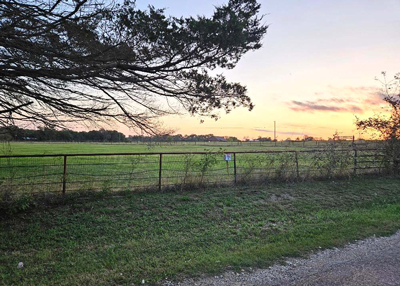
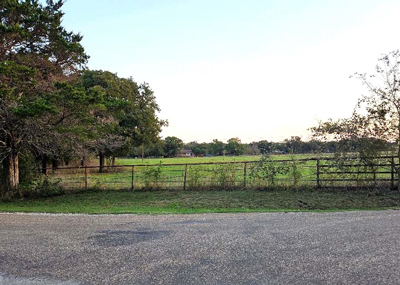
Answer: Imagine yourself standing at those windows looking out to the road. Your view would be a 500-ft.-long cone. The closer you are to the window, the narrower the cone would be. Which is to say, if you were to plant a few evergreens closer to the house you could get the privacy you want without having to do a long hedgerow. I also question whether something only 4 ft. tall would give you enough privacy at that distance.
Closer to the house I’d suggest Nellie R. Stevens hollies (grow to 15-18 ft. tall and 12-15 ft. wide) or Willowleaf hollies (grow to 8-12 ft. tall and 8-10 ft. wide).
Dwarf Burford holly grows to 5 or 6 ft. tall and 4 to 5 ft. wide.
If you wanted something out near the fence, I’d suggest eastern redcedar junipers. That’s what I’ve used across the creek from our house. I spaced mine varying distances (18-22 ft.) and in a zig-zag pattern so they would look natural when they grew larger (to 30 ft. tall). I’m not a big advocate of rows of plants in rural settings.
You’ll need to carry water to any types of plants for at least their first 2 or 3 years. If you fail to do so just one time you’ll lose all that time and effort. Putting a water line in to them isn’t as much work as you might think if you rent a trencher and use PVC pipe. You might want to consider that.
QUESTION 5
WILL MY ST. AUGUSTINE COME BACK NEXT SPRING?
Question: My St. Augustine was killed out by chinch bugs. I realized too late what was happening. By the time I got the insecticide applied it looked like my photo. Will it come back next spring, or will I have to resod the entire lawn? Dorothy C., Grayson County.

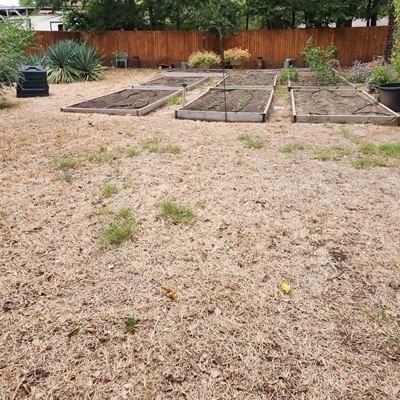
Answer: Ouch! Note that your photo was taken and received several days before this latest cold front blew in. This is not cold damage. This is all due to the chinch bugs, and sadly I’d be amazed if much of this comes back. I think you’ll have some replanting ahead of you come March or early April. For future summers, watch for first signs of their appearance from mid-June on. Treat at first signs of dry grass that doesn’t respond to irrigation. I know you’ll be watching for them.
QUESTION 6
WHAT IS CAUSING THESE TWO STRAIGHT LINES IN MY ZOYSIA?
Question: Every fall I get two dead lines in my zoysia lawn. The lines are 10 ft. long, and they are in the same place every year. I take care of my own lawn, so I know they’re not from mowing. I’ve treated with azoxystrobin and grub controls, but to no avail. Can you offer any suggestions? Rick M., Frisco.
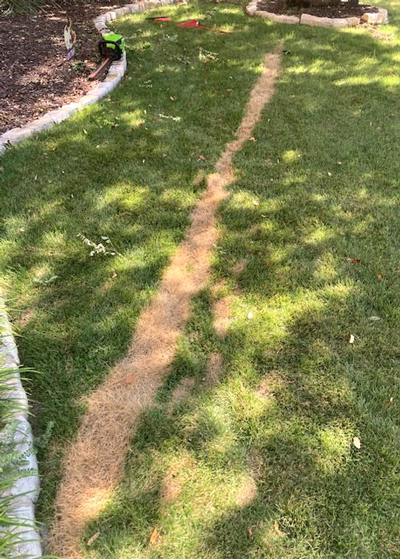
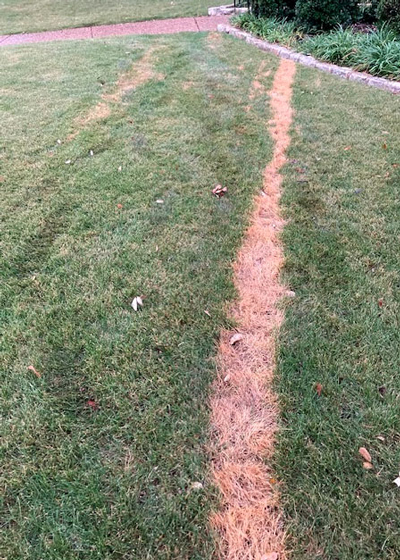
Answer: Grubs wouldn’t feed in a straight line. Normally, funguses wouldn’t develop in a straight line, either, except I do wonder about the Pythium blight that attacks bermuda. It causes odd lines that follow low areas in the lawn. Irrigation and fertilizer accumulate in those low spots, and the excesses result in the grass becoming “soft” and vulnerable. I wonder if something like that could be happening to your zoysia – if perhaps trenches or tire ruts are concealed by the grass, but still there to catch water and nutrients.
The other thing that crosses my mind is the possibility of something being buried there. If there were major pipes that had been laid where each of these lines appears, the toll of a hot, dry summer could have caused the browned grass. Use a dowel stick to do some probing to see if you hit anything solid.
You might want to use a hand trowel to take some actual soil samples out to see if there is an elongated ditch that might have gotten filled with sand and debris at the time of construction. Those could cause the grass to dry out before the adjacent turf.
I know those are lame and wild-eyed ideas, but they’re the best I have from here. Do a little sleuth work on your own. Good luck! Let me know what you discover.
QUESTION 7
ARE THE WEEDS THAT ARE SHOWING UP NOW THE RESULT OF A PROBLEM WITH MY LABOR DAY PRE-EMERGENT APPLICATION?
Question: Are the weeds that are popping up now because of an issue with my pre-emergent application from two months ago or from a prior application? Ronald B., Crowley (Tarrant County).
Answer: I can’t answer that without knowing what weeds are involved. For example, most of our cool-season weeds have only recently started to germinate now that we’ve had some rains here in the Metroplex where I also live and garden. They are still very tiny. But many people are just now seeing roadside asters in their lawns, even though the weed has been there all summer. It’s only noticeable for those folks now that it’s blooming.
If you’re seeing broadleafed weeds, unless you applied Gallery, the pre-emergent granules you used were probably intended to prevent grassy weeds.
So, there are too many unknowns. But to give you at least some kind of answer, this has been another difficult year to handle cool-season weeds. The application date didn’t change, but we went many weeks without rain that we needed to trigger germination of the weeds so the herbicides could do their best work.
QUESTION 8
HOW SHOULD I CARE FROM MY CALAMONDIN ORANGE PLANT?
Question: How should I care for my miniature Calamondin orange tree? I planted it from seed. It’s 2 ft. tall in an 8-in. pot. Should I trim it back including the top or just thin it out? What fertilizer should I use? Jack, W. Fort Worth.
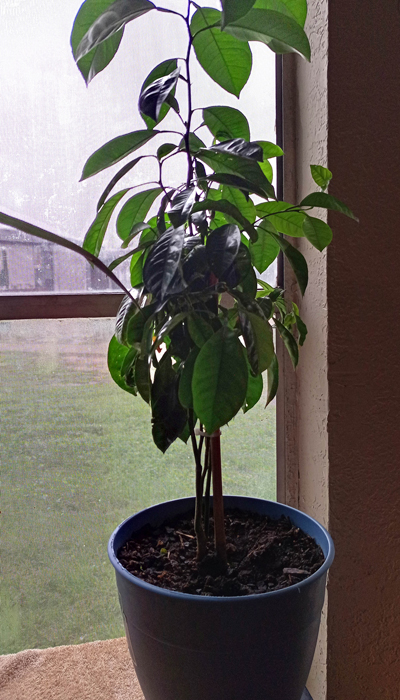
Answer: When you mentioned on the air that its trunk was “pencil lead thin” I thought it was much thinner than it actually is. Your tree looks fine. I’m glad you sent the photo. Since we’re going into the dark days of winter, I would suggest trimming only the tip growing straight up to keep it more compact and full. You can repot it as it gets larger in late spring or summer. As for the fertilizer, you won’t need to add much while it’s dark. Use a high-nitrogen, water-soluble product.
